A teacher showed students an example and explained the usage of past perfect tense,and ask students to listen“past perfect tense”sentences by imitating that example.What’s teacher's grammar teaching method?A.Consolidation. B.Presentation. C.Deduction. D.I
题目
A teacher showed students an example and explained the usage of past perfect tense,and ask students to listen“past perfect tense”sentences by imitating that example.What’s teacher's grammar teaching method?
A.Consolidation.
B.Presentation.
C.Deduction.
D.Induction.
B.Presentation.
C.Deduction.
D.Induction.
相似考题
参考答案和解析
答案:C
解析:
考查语法教学知识。
题干的意思:老师给学生展示例子和解释过去完成时的用法,让学生模仿例子列出十个过去完成时的句子,老师用的是什么教学方法?
C项,演绎法法,符合题意,故此题的正确选项为C。
A项,巩固;B项,新授;C项,归纳法,和演绎法相反;均不合题意,故排除。
故此题的正确选项为C。
题干的意思:老师给学生展示例子和解释过去完成时的用法,让学生模仿例子列出十个过去完成时的句子,老师用的是什么教学方法?
C项,演绎法法,符合题意,故此题的正确选项为C。
A项,巩固;B项,新授;C项,归纳法,和演绎法相反;均不合题意,故排除。
故此题的正确选项为C。
更多“A teacher showed students an example and explained the usage of past perfect tense,and ask students to listen“past perfect tense”sentences by imitating that example.What’s teacher's grammar teaching ”相关问题
-
第1题:
When students learn "apple, orange", the teacher gives students another word "fruit".Which principle doe, s the teacher follow in his/her vocabulary teaching?A.Word-choice principle.
B.Presentation principle.
C.Culture principle.
D.Systematic principle.答案:D解析:考查词汇教学的原则。系统性原则是指在词汇教学时要注意给学生展示词汇之间的系统性和联系性,如音形关系、形意关系、词形变化关系、反义词、同义词、上下位词等。题干中教师展示的词汇的上位词,故选D。A项指“词汇选择原则”,指选择目标词汇时,应当选择具有代表性的、能够用于其他活动的、经常出现的词汇。B项指“展示原则”,指展示新词时应当将其直观化、情景化和趣味化。C项指“文化原则”,是指语言是文化的载体,词汇结构、词义结构和搭配都该与该语言的文化相连。 -
第2题:
A teacher handed out a list of twenty"Fature tense" sentences and asked students to discuss and find out the grammatical structures. What is the teacher's grammar teaching method?A. Induction.
B. Presentation.
C. Consolidation.
D. Deduction.答案:A解析:考查语法教学。题目问的是:一位老师列出了二十个与将来时相关的句子.然后请学生讨论并找出将来时的语法结构,这位老师使用了哪种语法教学方法?语法教学的常用方法有两种:演绎法和归纳法。A项的Induction是归纳法;D项的Deduction是演绎法。本题中的教学方法很明显是归纳法。B项的新课展示和C项的巩固提高.都是教学环节,不是教学方法。因此选A项. -
第3题:
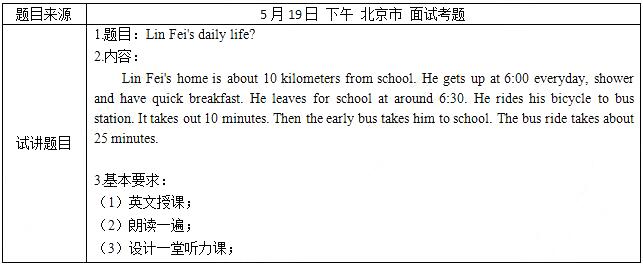
二、考题解析
【教案】
Teaching Aims:
Knowledge aim: Students will be able to describe their daily life and acquire some knowledge about listening strategies.题目来源于考生回忆
Ability aim: Students can obtain the main idea quickly from the listening material and develop the ability of grasping detail information.
Emotional aim: Students can foster the interest and desire of learning English, and be fond of taking part in kinds of practical activities.
Teaching Key Points:
Students can get the main idea and useful information from the listening material.
Teaching Difficult Points:
Students can apply these skills in their listening and apply these expression in their daily communication.
Teaching Methods:
Communicative teaching method, task-based teaching method, audio-lingual teaching method.
Teaching Aids:题目来源于考生回忆
PPT, Blackboard, recorder and so on
Teaching Procedures:
Step 1: Warming up
1.Greetings
2.Sing an English song It' my life, invite the whole students to clap when singing together and lead to the topic.
Step 2: Pre-listening
1.Free talk: Give students three minutes to talk about their own daily life and invite them to share it.
2.Prediction: Let students work in pairs and ask them to predict Lin Fei's daily life.
Step 3: While-listening
1. Listen to the tape for the first time and ask them when Lin Fei gets up and when he goes to school, then let students to share answers.题目来源于考生回忆
2.Listen to the tape for the second time and ask them to fill in the chart, then invite them to share their answers.
Step 4: Production
1.Retelling: Ask students to retell Lin Fei's daily life with the help of the chat in their own words, and teacher will give them 3 minutes to prepare it and 3 minutes later, invite some students to share their retelling in the front.
2.Survey: Let students discuss their own daily life in the group of four and make a report in the form of chart. 8 minutes later teacher invites some groups to share the result of their reports.
Step 5: Summary & Homework
Summary : Invite a little teacher to help teacher make a summary of this class.
Homework: Let students introduce their daily life to their parents and make a share in the next class.
Blackboard design:
 答案:解析:暂无解析
答案:解析:暂无解析 -
第4题:
小学英语?语法
一、考题回顾

二、考题解析
【教案】
Teaching aims:
Knowledge aim:
Students will grasp the usage of simple past tense.
Ability aim:
Students will improve their speaking ability in describing things happened in the past.
Emotional aim:
Students will be more confident in speaking English.
Students will arouse their interest in learning oral English.
Key and difficult point:
Key Point:
Students will grasp the usage of simple past tense.
Students will improve their speaking ability in describing things happened in the past.
Difficult Point:
Students will be more confident in speaking English.
Students will arouse their interest in learning oral English.
Teaching procedure:
Step 1: Warming-up
1. Greetings. Talk about the weather.
2. Sing a song called Yesterday Once More, and introduce today’s topic.
Step 2: Presentation
1. Read the dialogue by the teacher, and ask what the dialogue is about.
2. Let the students open the book and read it for the second time, then ask the students to circle the verb in it and ask the similarities among them. They may say that they are different from the verbs they learned. “-ed” is added in some verbs at the end.
3. Tell them that simple past tense is a tense that is used to describe things happened in the past. When we apply it, you should change the verb into past tense. Then introduce the regular and irregular verbs.
Step 3: Practice
1. Fill in the blanks.
a. I _____(clean) the table after we had lunch last evening.
b. My father_____(go) to the company yesterday.
Step 4: Production
1. Make a dialogue with their deskmates about what the students did last weekend. Then invite some students to share their dialogue with their parents.
2. Ask the students to make up a simple story or a joke. Then invite some students to share it with us.
Step5: Summary and Homework
Summary: make a brief summary of what we have learned today.
Homework: Tell the story or the joke to their parents.
Blackboard design:

1. Please talk about your understanding of simple past tense.
2. How do you stimulate students’ interest in learning grammar?答案:解析:1.
Simple past tense is a tense used to describe things happened in the past. When we use it, we need to change the verb into past tense. The verbs are changed in regular form or regular form. Regular verb only needs to add -ed at the end of a word, while irregular verbs have various forms. I will now show an example: My friend looked at me when I touched him. So that’s my understanding of simple past tense.
2.
Grammar can be a little boring for students. But it is essential to learn English. So different activities can be arranged to attract their attention. For example, in the warming-up, I sang a song called Yesterday Once More so that they will know this grammar point is around us and frequently used. Then, in the presentation part, I will let the students take the initiative to find the rules of simple past tense. At last, I asked students to talk about their daily lives and share stories or jokes with simple past tense, so they will use the tense and do not get bored with much mechanical drilling. So I believe they will be interested in my grammar lesson. -
第5题:
初中英语《Lin Fei's daily life?》
一、考题回顾
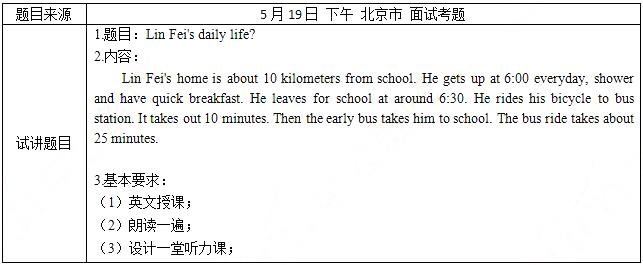
二、考题解析
【教案】
Teaching Aims:
Knowledge aim: Students will be able to describe their daily life and acquire some knowledge about listening strategies.题目来源于考生回忆
Ability aim: Students can obtain the main idea quickly from the listening material and develop the ability of grasping detail information.
Emotional aim: Students can foster the interest and desire of learning English, and be fond of taking part in kinds of practical activities.
Teaching Key Points:
Students can get the main idea and useful information from the listening material.
Teaching Difficult Points:
Students can apply these skills in their listening and apply these expression in their daily communication.
Teaching Methods:
Communicative teaching method, task-based teaching method, audio-lingual teaching method.
Teaching Aids:题目来源于考生回忆
PPT, Blackboard, recorder and so on
Teaching Procedures:
Step 1: Warming up
1.Greetings
2.Sing an English song It' my life, invite the whole students to clap when singing together and lead to the topic.
Step 2: Pre-listening
1.Free talk: Give students three minutes to talk about their own daily life and invite them to share it.
2.Prediction: Let students work in pairs and ask them to predict Lin Fei's daily life.
Step 3: While-listening
1. Listen to the tape for the first time and ask them when Lin Fei gets up and when he goes to school, then let students to share answers.题目来源于考生回忆
2.Listen to the tape for the second time and ask them to fill in the chart, then invite them to share their answers.
Step 4: Production
1.Retelling: Ask students to retell Lin Fei's daily life with the help of the chat in their own words, and teacher will give them 3 minutes to prepare it and 3 minutes later, invite some students to share their retelling in the front.
2.Survey: Let students discuss their own daily life in the group of four and make a report in the form of chart. 8 minutes later teacher invites some groups to share the result of their reports.
Step 5: Summary & Homework
Summary : Invite a little teacher to help teacher make a summary of this class.
Homework: Let students introduce their daily life to their parents and make a share in the next class.
Blackboard design:
 答案:解析:暂无解析
答案:解析:暂无解析 -
第6题:

二、考题解析
【教案】
Teaching aims:
Knowledge aims:
Students will know how to describe a day using proper conjunctions and tense.
Students will master some words, such as waste, value... and a sentence structure: I usually + simple present tense.
Ability aim:
Students will improve their abilities of speaking and listening.
Emotional aim:
Students will be more confident in speaking English.
Key and difficult point:
Key Point: Students will know how to introduce a day in English.
Difficult Point: Students will use the sentence structure in real communicative situation.
Teaching procedure:
Step 1: Warming-up
1. Greetings.
2. Play a video about Tom’s day and ask students what kind of information have they caught.
Step 2: Pre-listening
1. Review the knowledge about simple present tense. Ask students to make sentences using simple present tense.
2.Using pictures to explain some words: waste-value, brush.
Step 3: While-listening
1st listening: Ask students to listen to the tape for the first time and try to get the main idea of the passage and underline the conjunctions used.
2nd listening: Ask students to listen to the tape for the second time and complete the timetable below.
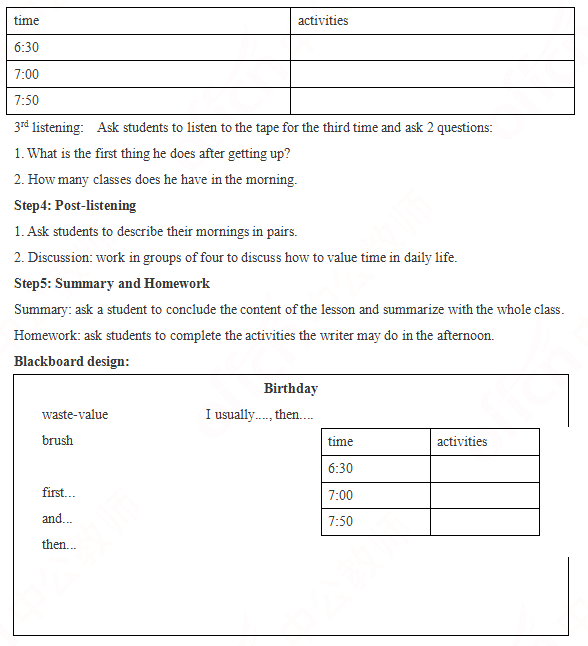 答案:解析:暂无解析
答案:解析:暂无解析 -
第7题:
初中英语?语音
一、考题回顾
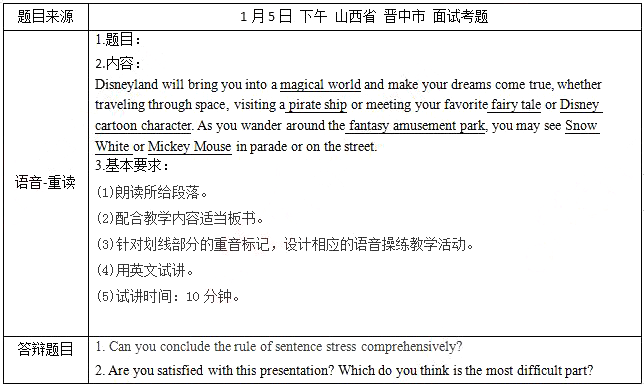
二、考题解析
【教案】
Teaching aims:
Knowledge aim:
Students will know the rule of logical stress in a complete sentence.
Ability aim:
Students will use the logical stress correctly and know how to make use of the sentence stress in different sentences correctly.
Emotional aim:
Students will be more confident in speaking English.
Key and difficult point:
Key Point: Students will master the rule of logical stress in sentences in English.
Difficult Point: Students can use the logical stress in sentences in daily life.
Teaching procedure:
Step 1: Warming-up
1. Greetings.
2. Listen to an English song and feel about the tune of the melody. Let students to know that not only songs but also the language has its stress in order to express different emotions.
Step 2: Presentation
1. Work in pairs to read the passage by themselves and ask them to pay more attention to the sentence stress. After practice, ask one pair to perform it and others should tell their opinion whether they agree or not.
2. Listen to the tape of the passage and find out whether the students themselves make any mistakes. Then let students find out the rule of the sentence stress (logical stress ) with the help of the teacher: in a sentence we can stress the important part according to the meaning of the passage. After the students find the rule, the teacher read the passage and let them repeat after it.
Step 3: Practice
1. Ask students to read the passage by themselves again and they should use the correct logical stress while reading.
2. Give students more sentences and ask them read the sentences by themselves using the logical stress.
Step4: Production
Let students work in groups of 4 and make a dialogue about the theme parks, such as the theme, the feature, the activities and so on, and they should use the rule of logical stress learned in the class. After that invite two groups to share their outcomes with the whole class.
Step5: Summary and Homework
Summary: ask a student to conclude the content of the lesson and summarize with the whole class.
Homework: ask students to read the work of Shakespeare’s and use the logical stress learned today after class.
Blackboard design:
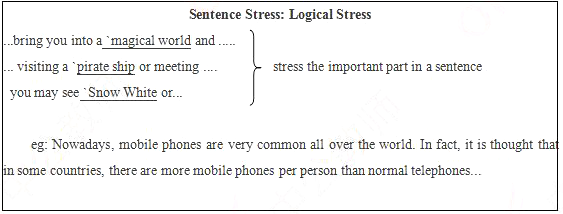
1. Can you conclude the rule of sentence stress comprehensively?
2. Are you satisfied with this presentation? Which do you think is the most difficult part?答案:解析:1.
As far as I’m concerned, there are two sentence stress rules: logical stress and grammatical stress. Logical stress is what i have presented in the presentation. The grammatical stress refers to that we need to stress notional word, which usually contains noun, verb, adjective adverb and so on. At the same time, the functional word needn’t to be stressed, which usually includes conjunction, article and preposition.
2.
The difficulty in my eyes is: first of all, without the participation of students, because of the teaching reasons, I can not interact effectively with students based on their feedback. In this case, it is difficult for me to organize classroom teaching activities and achieve the desired results. Second, what I need to improve is to introduce the key points to the students in a way that is easy to accept and adapt to the environment without an atmosphere of spoken English, because my spoken English is not very fluent, and I am very concerned about this interview. So I felt a little nervous. However, all these factors did not affect my overall performance. In view of the above problems, I will constantly reflect, and learn from experience in practice to improve my teaching ability. In short, I am basically satisfied with the presentation. -
第8题:
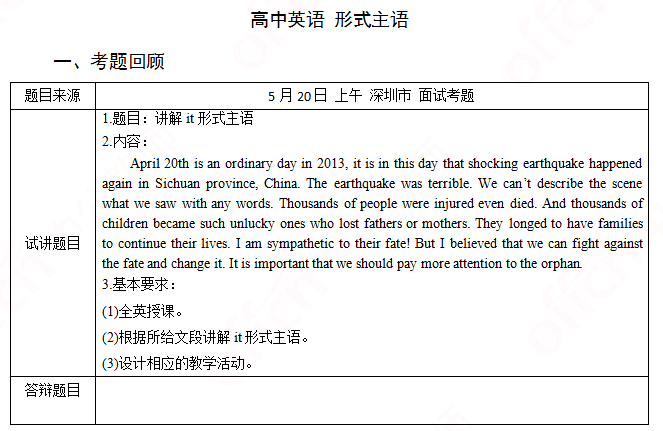
二、考题解析
【教案】
Teaching aims:
Knowledge aim: Students can master the usage of formal subject.
Ability aim: Students can use formal subject to communicate in their daily life.
Emotional aim: Students can enhance their interest in learning English.
Key and difficult point: Students can use formal subject to communicate in their daily life.
Teaching procedure:
Step 1: Warming-up
The teacher plays a documentary video about the earthquake in Wenchuan. Then asks students to talk about their feelings after watching. And lead in the topic.
Step 2: Presentation
The teacher lets students to read the passage and get the main idea. Then the teacher picks the last sentence out. The teacher will use the sentence as example to explain the structure and usage of formal subject.
Step 3: Practice
After explaining, the teacher will show some normal sentences. Students should transfer them into formal subject structure.
For example: Taking good care of the orphans is very important.
→It is very important to take good care of the orphans.
Step4: Production
The teacher lets students talk with their deskmates. They should come up with some ways to help the orphans. Then invites some students to show their opinions.
Step5: Summary and Homework
The teacher summarizes what they have learnt today. Then after class, students could say something to these orphans and take a video. The teacher will help them sent it to the orphan.
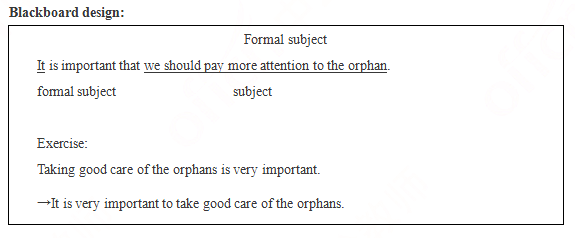
答案:解析:暂无解析 -
第9题:
初中英语《口语教学活动》
一、考题回顾

二、考题解析
【教案】
Teaching Aims:
Knowledge aim: Students will master the sentence structure “We have great bags for only ¥12! we have....for only....; You can buy...for only .... ”.
Ability aim: Students can use these sentence structures to apply in their daily life.
Emotional aim: Students will improve their confidence of learning English and not afraid of speaking English in Class.
Teaching Key Points:
Students know the expressions about describing great sale and master the sentence structure.
Teaching Difficult Points:题目来源于考生回忆
Students can apply the expressions into daily communication.
Teaching Methods:
Communicative teaching method, task-based teaching method, situational teaching method.
Teaching Aids:
PPT, Blackboard and so on
Teaching Procedures:
Step 1: Warming up
1.Greetings
2.Play a video about an advertisement of Huawei phone and invite students to talk about the content of this video.Then the teacher leads in the topic of “Huaxing’s great sale.”
Step 2: Pre-speaking
1.Show two pictures about Huaxing store and its great sale advertisement.
2.Let students listen to the tape and find out what things are at great sale.
3.Ask students to listen to the tape again and collect the useful expressions about great sale.
Step 3:While-speaking
1. Ask students to read Huaxing’s store’s advertisement actively and vividly.
2. Let students talk about the expressions of great sale.题目来源于考生回忆
3. Role-play: students work in pairs to make conversation.Suppose there is a situation that you own a store. One student is shop assistant, the other students is customer. Teacher will give them 8 minutes to prepare it.
Step 4: Post-speaking
Share and evaluation: Invite some students to perform the conversation in the front.
Step 5: Summary & Homework
Summary: let them look at the blackboard and summarize this class.
Homework: Ask students to design a poster of their own store’s great sale and share it next class.
Blackboard design:
 答案:解析:暂无解析
答案:解析:暂无解析 -
第10题:
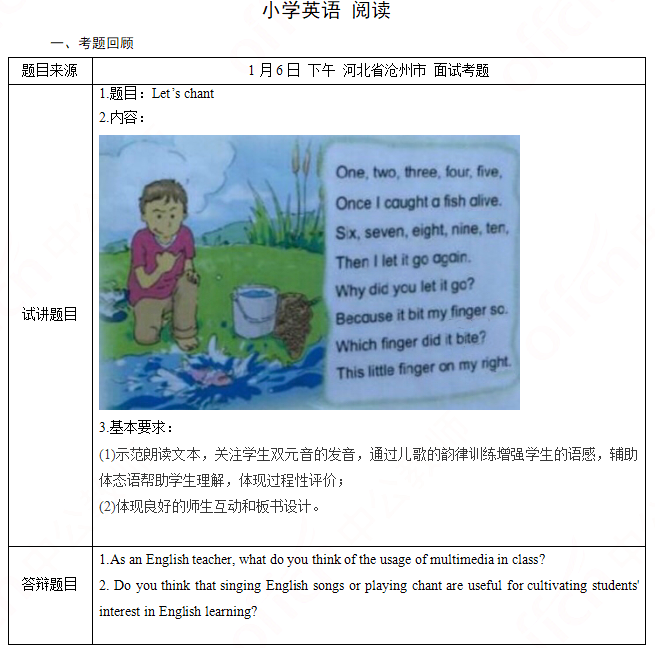
二、考题解析
【教案】
Teaching aims:
Knowledge aim:
Students will master the sound /ai/ in the words “five”, “alive” and so on.
Ability aim:
Students will apply the sound correctly in real communication.
Emotional aim:
Students will be more interest in speaking English.
Key and difficult point:
Key Point: Students will master the sound /ai/ in the words “five”, “alive” and so on.
Difficult Point: Students will apply the sound correctly in real communication.
Teaching procedure:
Step 1: Warming-up
1. Greetings.
2.Play a chant they have learned “tomato, tomato, wash, wash, wash” and lead them to learn another chant this class..
Step 2: Presentation
1. Students watch the picture and tell the teacher what they can see in the picture, and the teacher guide them to present the first part of the chant. Then students watch the picture carefully and predict what’s wrong with the boy, then the teacher guide them to present the last part of the chant.
2. Students observe the sentences and find out what common letters they can find.
3. The teacher teaches them correct pronunciation of the letter “i” in “five”, “right” and so on.
Step 3: Practice
1. Read the pronunciation /ai/ and the words that includes “i” repeatedly.
2. Listen to the tape and follow the tape, paying attention to the intonation of the chant.
3. Students work in pairs to make a chant in 5 minutes.
Step4: Production
1. The teacher writes more words that includes the sound /ai/and students try to read them.
2. Students work in groups to make a story using the picture and the words with the sound /ai/ on the blackboard.
Step5: Summary and Homework
Summary: ask a student to conclude the content of the lesson and summarize with the whole class.
Homework: ask students to search other pronunciation of the letter “i” and list those words accordingly.
Blackboard design:

1. As an English teacher, what do you think of the usage of multimedia in class?
2. Do you think that singing English songs or playing chant are useful for cultivating students' interest in English learning?答案:解析:1.
Multimedia help students to understand our class more smoothly and vividly and enhance their thinking ability. With images, audios and videos, knowledge that is difficult to understand in English is well presented. The students can more truly feel the content of the text, which is helpful to solve difficulties. In the environment of multimedia students can also develop abstract thinking and divergent thinking.
2.
As far as the activity such as singing or chant itself is concerned, it is very interesting and can attract students' attention. The time for students to keep concentrating is limited. If you add such activities as some songs and chants that students like, you can not only attract students' attention, but also cultivate their interest in learning. Therefore, combining knowledge and activities in the classroom allows students to learn while playing and even achieve better effects. -
第11题:
单选题Think about when a teacher handed out a list of twenty Past tense sentences and asked students to discuss and find out the grammatical structures. What is the teacher's grammar teaching method?AInduction.
BPresentation.
CConsolidation.
DDeduction.
正确答案: A解析: -
第12题:
单选题A teacher lists twentysimple present tensesentences and asks students to discuss and find out the grammatical structures. What's the teacher's grammar teaching method?AInduction.
BConduction.
CConstruction.
DDeduction.
正确答案: B解析: -
第13题:
A teacher handed out a list of twenty "Future tense"sentences and asked students to discuss and find out the grammatical structures. What is the teacher's grammar teaching method?A.Induction.
B.Presentation.
C.Consolidation.
D.Deduction.答案:A解析:考查语法教学。题目问的是:一位老师列出了二十个与将来时相关的句子,然后请学生讨论并找出将来时的语法结构,这位老师使用了哪种语法教学方法 语法教学的常用方法有两种:演绎法和归纳法。A项的Induction是归纳法;D项的Deduction是演绎法。本题中的教学方法很明显是归纳法。B项的新课展示和C项的巩固提高,都是教学环节,不是教学方法。因此选A项。 -
第14题:
A teacher showed students an example and explained the usage of past perfect tense, and ask students to list ten “past perfect tense” sentences by imitating that example. What’s teacher's grammar teaching method?A.Consolidation.
B.Presentation.
C.Deduction.
D.Induction.答案:C解析:考查语法知识教学。
题干的意思:老师给学生展示例子和解释过去完成时的用法,让学生模仿例子列出十个过去完成时的句子,老师用的是什么教学方法?
C项,演绎法,符合题意,故此题的正确选项为C。
A项,巩固;与题意不符,故排除。
B项,新授;与题意不符,故排除。
D项,归纳法,与题意不符,故排除。
故此题的正确选项为C。 -
第15题:
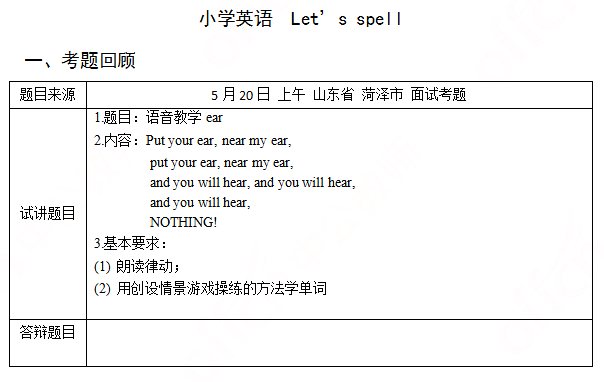
二、考题解析
【教案】
Teaching aims:
Knowledge aim: Students can understand the pronunciation of “ear”, and get some simple spelling rules.
Ability aim: Students can read the words with the pronunciation of “ear” correctly by listening and speaking. Ability of listening and speaking will be improved.
Emotional aim: Students can increase their interests in learning English.
Key and difficult point:
Key points: Students can understand the pronunciation of “ear”, and how how to read the words contain “ear”, such as hear, near and etc.
Difficult points: Students can master the pronunciation of “ear” and read the related words correctly.
Teaching procedure:
Step 1: Warming-up
Greeting the students.
Sing a song: Head shoulder keens and toes.
Step 2: Presentation
1. Show the chant and ask the students the question: Can you find the same letter combination in these words?
2. Listen to the tape and let students pay attention to the pronunciation of “ear”, and then ask the students question: what does “ear” sounds like in these words?
3. Teacher the pronunciation of “ear” ,and let students pay attention to the teacher’s mouth.
4. Game: Play the finger show to practice the new words.
Step 3: Practice
Find more words with “ear” such as tear, dear, clear... and ask students to try to read by themselves and then invite some of them to share with the class. The teacher should act the role of monitor.
Step4: Production
1. Ask students to make up their own sentences by using the words learned today, such as “He hears the bad news,and then his tears falls down. ”.
2. Reading competition: let students to read the chant as quickly as possible, and then let students choose the best one.
Step5: Summary and homework
1. Summary: ask students summary what have learned in the class.
2. Homework:
(1) read these word after class.
(2) Find more words with “ear” and make another chant.
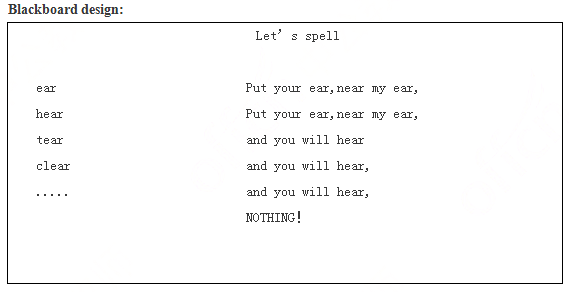 答案:解析:暂无解析
答案:解析:暂无解析 -
第16题:

二、考题解析
【教学过程】
Teaching aims:
Knowledge aim:
Students can get some knowledge about the city Pompeii.
Ability aim:
Students can use the past perfect tense to describe a place.
Emotional aim:
Students will be interested in foreign history and have the desire to explore unknown things.
Key and difficult point:
Key Point: Students can fully understand the passage and find required information.
Difficult Point: Students can cultivate the curiosity towards foreign history.
Teaching procedure:
Step 1: Warming-up
1. Greet the students.
2. Show some pictures of culture relics and introduce some background knowledge about them.
Step 2: Pre-reading
1. Use pictures and videos to teach new words: Volcanic eruption, buried, event, etc.
2. Exhibit the picture of Pompeii and ask students whether they know something about this city. Invite several people to briefly talk about it.
Step 3: While-reading
1. Read the text quickly and find the main content of the passage.
2. Read it for the second time. Students need to complete the timeline after reading the passage.答案:解析: -
第17题:
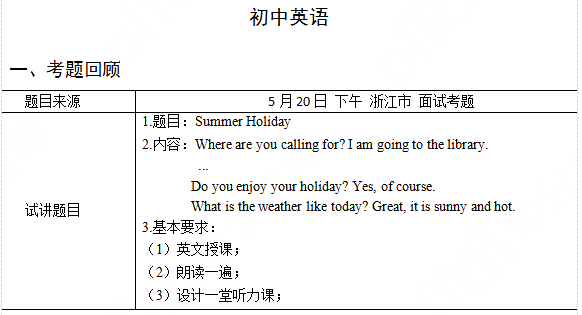
二、考题解析
【教案】
Teaching Aims:
Knowledge aim: Students will be able to describe their summer holiday and acquire some knowledge about listening strategies.
Ability aim: Students can obtain the main idea quickly from the listening material and develop the ability of grasping detail information.
Emotional aim: Students can foster their interest and desire of learning English, and be fond of taking part in kinds of practical activities.
Teaching Key Points:
Students can get the main idea and useful information from the listening material.
Teaching Difficult Points:
Students can apply these skills in their listening and apply these expression in their daily communication.
Teaching Methods:
Communicative teaching method, task-based teaching method, audio-lingual teaching method.
Teaching Aids:
PPT, Blackboard, recorder and so on
Teaching Procedures:
Step 1: Warming up
1.Greetings
2.Sing an English song Summer Holiday, invite the whole students to clap when singing together and lead to the topic.
Step 2: Pre-listening
1.Brainstorm: Give students 3 minutes to say something about summer holiday as much as they can.
2.Clean up obstacle:Use pictures to teach students some difficult words or explain some words by English explanation.
Step 3: While-listening
1. Listen to the tape for the first time and ask them what the passage is mainly about, then let students share their ideas.
2.Listen to the tape for the second time and ask them to fill in the chart, then invite them to share their answers.
Step 4: Post-listening
1.Discussion: Ask students to discuss what they will do this summer holiday with their partners, and teacher will give them 3 minutes to prepare it and 3 minutes later, invite some students to share their own summer holiday in the front.
2.Report: Let students to write down plans of their own summer holiday with the key words and key sentences that they have learned today, 8 minutes later teacher invites some students to share the result of their reports.
Step 5: Summary & Homework
Summary : Invite a little teacher to help teacher make a summary of this class.
Homework: Let students prefect their plans of summer holiday and share with their parents.
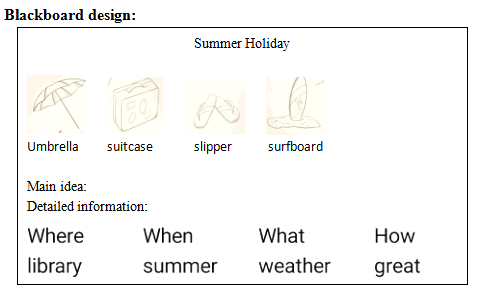 答案:解析:暂无解析
答案:解析:暂无解析 -
第18题:
高中英语?语法
一、考题回顾
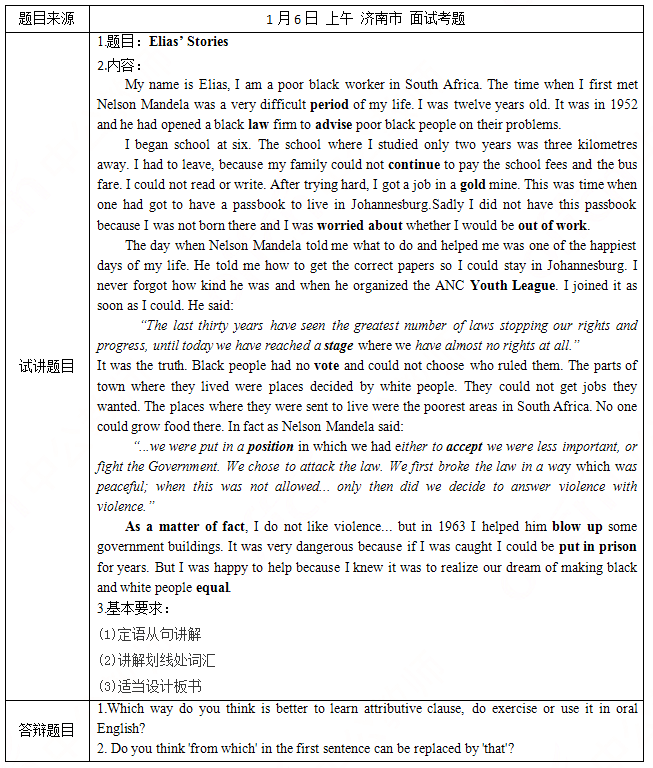
二、考题解析
【教案】
Teaching aims:
Knowledge aims:
(1)Students are able to master the meaning of bold words and phrases: period, law, advise, gold, worried about, out of work, Youth League, stage, stage, position, as a matter of fact, blow up, put in prison, equal
(2)Students can master the usage of adverb in attributive clause.
(3)After this lesson, students can know the difference of usage of adverb in attributive clause and the usage of pronoun in attributive clause.
Ability aim:
After this lesson, students can use grammar of attributive clause in reading and writing.
Emotional aim:
Students are able to love learning English after this lesson.
Key and difficult point:
Key Point: master the meaning of words and phrases :period, law, advise,gold,worried about etc.
Difficult Point: use grammar of attributive clause in reading and writing
Teaching procedures:
Step 1: Warming-up
1. Greetings.
2. Ask students to make several sentences using the grammar of usage of pronoun in attributive clause. Then write a sentence needing to use adverb in attributive clause. And then lead in the new grammar, adverb in attributive clause.
Step 2: Presentation
1.Ask students to open the book and read the passage to guess the meaning the bold words and then paraphrase the bold words with the help of PPT.
2. Then Ask students to find out more complex sentences that the clause is after a noun or pronoun and the words that are used to introduce the sentences: where, when, why or preposition plus which.
The time( when I first met Nelson Mandela )was a very difficult period of my life.
The school (where I studied only two years) was three kilometres away.
This was time (when one had got to have a passbook )to live in Johannesburg.
we were put in a position (in which we had either to accept we were less important, or fight the Government). ...
Then ask students to find the similarity of these sentences and invite several students to share their ideas. Then lead the students to conclude the rules of relative adverb in attributive clause and preposition plus which in attributive clause. (They all function as adverbials)
Step 3: Practice
1.Make sentences: Ask students to use the grammar that has just learnt to describe the pictures which are presented on the PPT.
2.Combine the sentences: Ask students to combine the sentences according to the grammar in attributive clause.
(1)This is a book. Its cover is blue. (whose)
(2)He is the teacher. He helped me. (who/that)
(3)Beijing is the place. I was born in this place. (where/ in which)
(4)This is the hotel. You will stay at the hotel. (where/at which)
Step4: Production
1.Make stories: Ask students to use the grammar that has just learnt to describe the video.
2.Discussion: Ask students to tell their daily life to use the grammar that has just learnt. And after 5minutes to invite several students to share their daily life.
Step5: Summary and Homework
Summary: ask a student to conclude the content of the lesson and summarize with the whole class.
Homework: write a short passage about his daily life using the grammar that has just learnt.
Blackboard design:
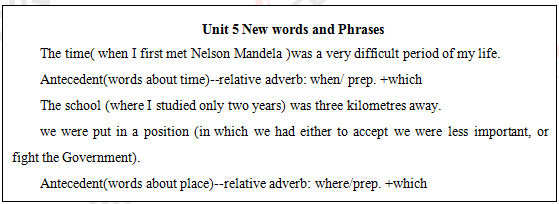
1.Which way do you think is better to learn attributive clause, do exercise or use it in oral English?
2. Do you think 'from which' in the first sentence can be replaced by 'that'?答案:解析:1.
(1)I think, first, the best way to learn attributive clause is tell the definition of this grammar in
sentence. For example, this is a beautiful teacher (who wears the red dress )is our teacher. Then ask students to pay attention to the clause to find the features of this sentence and conclude the attributive clause: noun/pronoun plus a whole sentence. Next tell the usage of pronoun in attributive clause. Last, teach the usage of adverb in attributive clause.
(2) Exercise and oral English should use togerther in practice attributive clasue. Doing exercise can make students master the structure of this grammar easily. And oral English can make students know the real situation of attributive clause in our daily life.
2.
No, I don’t think. From which is an relative adverb from the point of grammar. And that belongs to the pronoun. So it only can be used as the subject, object and so on but can not be used as the adverb or as as phrase. And this sentence doesn’t have the adverb, so we must use from which. -
第19题:
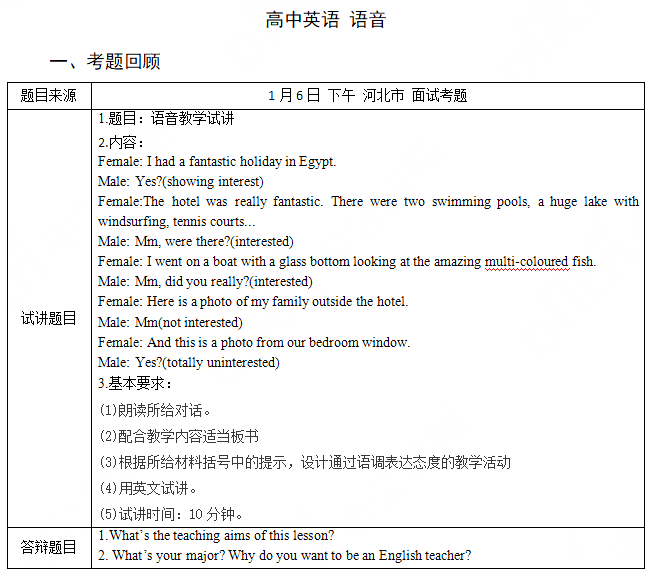
二、考题解析
【教案】
Teaching aims:
Knowledge aim:
Students can master the intonation of showing their attitudes.
Ability aim:
After this lesson, students can practice their listening and speaking ability through group work.
Emotional aim:
Students are able to love learning English after this lesson.
Key and difficult point:
Key Point: master the intonation of showing their attitudes.
Difficult Point: cultivate the interest of students’ learning English.
Teaching procedures:
Step 1: Warming-up
1. Greetings.
2. Play a video about a person who is shopping at a store and has a conversation with the shop assistant. And ask students to answer some questions: Does this customer want to buy the clothes? Give the reason
Step 2: Presentation
1.Ask students to listen the conversation carefully and the teacher reads the conversation that today needs to learn and ask students:
Which part does the male show the interest? Give the reason
And which part does the male show the uninterested? Give the reason
2.Then present the conversation on the PPT, and ask students to listen to the conversation again, pay attention to the intonation of male’s answers. And ask students to answer some questions:
When male shows the interest to the content of female’s saying, what kind of intonation does he use? Uninterested, what’s intonation?
3. Then lead the students to conclude the rules of intonations of showing their attitudes. At the same time, write the male’s words on the blackboard with the help of symbols of rising tone and falling tone.
Step 3: Practice
1.Ask students to read this conversation after the tape.
2.Role-play: Ask students to practice this conversation with their partner and after 5 minutes, invite some students to read this conversation for all the students.
3. Dubbing: Ask students to look at a short video about a conversation between a Chinese student and another foreign student. But this video only has the frames, but doesn’t have the sound, which needs students to finish dubbing with their deskmates in given 10 minutes. Then invite several students to show their conversation with all the students.
Step4: Production
Make stories: Ask students to use the knowledge of intonation to make a short story according to the chart. Before this, divide the students into several groups with different persons and ask the representatives to get their topic through the way of random draw.
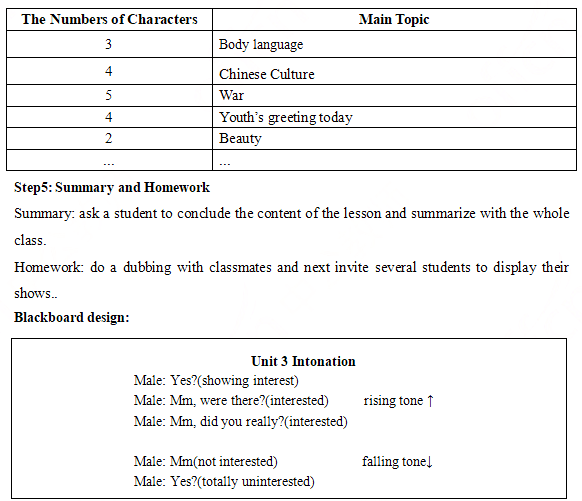
1.What’s the teaching aims of this lesson?
2. What’s your major? Why do you want to be an English teacher?答案:解析:1.
There are three aims: knowledge aim,ability aim and emotional aim.
Knowledge aim:
Students can master the intonation of showing their attitudes.
Ability aim:
After this lesson, students can practice their listening and speaking ability through group work.
Emotional aim:
Students are able to love learning English after this lesson.
2.
My major is medicine. But I like English. And my biggest hobby is learning and speaking English. In my daily life, I like to go abroad to travel and reading English novels. I think English is more useful and attracting for me than my major, medicine. -
第20题:

二、考题解析
【教案】
Teaching Aims:
Knowledge aim: Students will master the sentence structure “We have great bags for only ¥12! we have....for only....; You can buy...for only .... ”.
Ability aim: Students can use these sentence structures to apply in their daily life.
Emotional aim: Students will improve their confidence of learning English and not afraid of speaking English in Class.
Teaching Key Points:
Students know the expressions about describing great sale and master the sentence structure.
Teaching Difficult Points:
Students can apply the expressions into daily communication.
Teaching Methods:
Communicative teaching method, task-based teaching method, situational teaching method.
Teaching Aids:
PPT, Blackboard and so on
Teaching Procedures:
Step 1: Warming up
1.Greetings
2.Play a video about an advertisement of Huawei phone and invite students to talk about the content of this video.Then the teacher leads in the topic of “Huaxing’s great sale.”
Step 2: Pre-speaking
1.Show two pictures about Huaxing store and its great sale advertisement.
2.Let students listen to the tape and find out what things are at great sale.
3.Ask students to listen to the tape again and collect the useful expressions about great sale.
Step 3:While-speaking
1. Ask students to read Huaxing’s store’s advertisement actively and vividly.
2. Let students talk about the expressions of great sale.
3. Role-play: students work in pairs to make conversation.Suppose there is a situation that you own a store. One student is shop assistant, the other students is customer. Teacher will give them 8 minutes to prepare it.
Step 4: Post-speaking
Share and evaluation: Invite some students to perform the conversation in the front.
Step 5: Summary & Homework
Summary: let them look at the blackboard and summarize this class.
Homework: Ask students to design a poster of their own store’s great sale and share it next class.
Blackboard design:
 答案:解析:暂无解析
答案:解析:暂无解析 -
第21题:
初中英语?语法
一、考题回顾
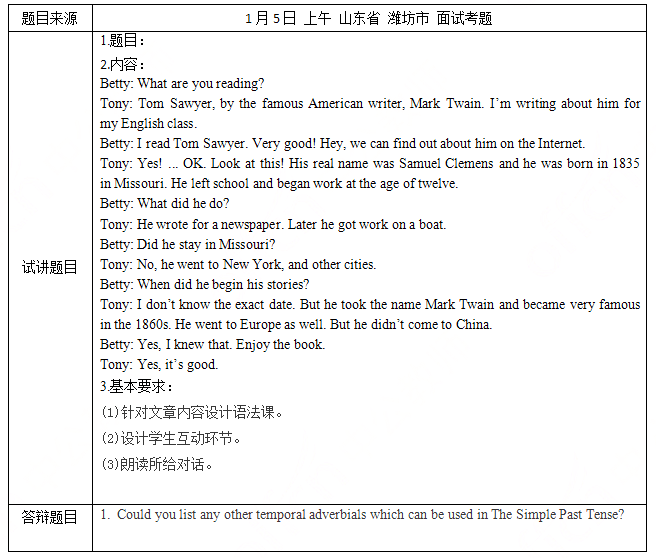
二、考题解析
【教案】
Teaching aims:
Knowledge aim:
Students will master the rule of the Simple Past Tense.
Ability aim:
Students will able to talk about the things happened in the past in their daily life.
Emotional aim:
Students will learn how to cooperate with others.
Key and difficult point:
Key Point: Students will master the structure of the Simple Past Tense.
Difficult Point: Students will use the structure of the Simple Past Tense in daily life.
Teaching procedure:
Step 1: Warming-up
1. Greetings.
2. Ask students a question: what are you reading recently? And ask some students to share with the whole class.
Step 2: Presentation
1. Review the knowledge about the past tense of verbs: write some verbs on the blackboard and ask students to change the verbs into their past tense.
2. Ask students to read the dialogue and pay attention to the background information about Mark Twain. Then ask students some questions: What’ Mark Twain’ real name? When did he born? When did he begin to work? And then invite some students to share the answers with the whole class and write down on the blackboard.
3. Then ask students when these things happened and then tell them the rule of past tense: Simple Past Tense refers to the actions or states happened at a certain moment in the past, or a certain period of time in the past. It is often used with temporal adverbial, such as yesterday, last week and so on.
4. Ask students to read the dialogue again and try to find other sentences which used the Simple Past Tense and share with class. Then tell students the rule of general and special interrogative sentences in the past tense: general interrogative sentences use auxiliary verbs (did) and special interrogative sentences use special interrogative words (what, when, how...).
Step 3: Practice
1. Ask student to role play the dialogue and ask two groups to show in class.
2. Play a game: magic box. There is a magic box which is full of all kind of verbs, ask students to choose one card and then make a sentence with it using the Simple Past Tense.
Step4: Production
Discussion: ask students to talk about what happened to them in the last weekend, they should use the Simple Past Tense and then invite two of them to show their conversation.4 in 1, 5 minutes will be given.
Step5: Summary and Homework
Summary: ask a student to conclude the content of the lesson and summarize with the whole class.
Homework: ask students to practice the usage of Simple Past Tense learned today with desk mates after class.
Blackboard design:
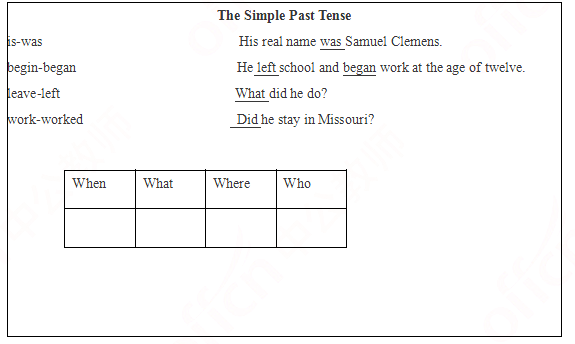
1. Could you list any other temporal adverbials which can be used in The Simple Past Tense?答案:解析:Usually, we can use yesterday, last night/night/month/weekend/year, the day before yesterday, in 1992 (a year in the past), in the 1990s, at the age of 16 and so on. -
第22题:
单选题When students are given the structure in an authentic or near authentic context and are asked to work out the rule for themselves, what kind of method their teacher is using?ADeductive grammar teaching.
BInductive grammar teaching.
CTraditional grammar teaching.
DCommunicative teaching.
正确答案: B解析: -
第23题:
单选题A teacher lists twenty" simple present tense" sentences and asks students to discuss and find out the grammatical structures. What's the teacher's grammar teaching method?AInduction.
BConduction.
CConstruction.
DDeduction.
正确答案: C解析:
